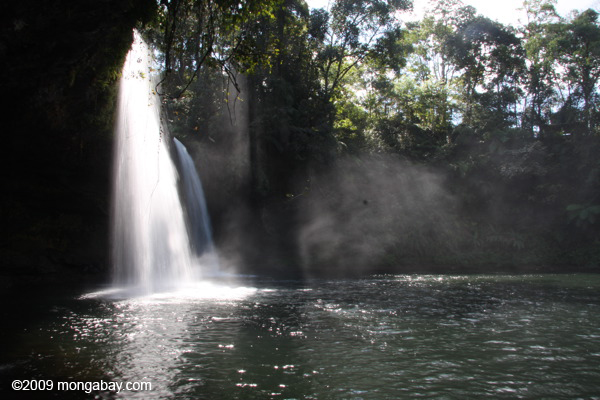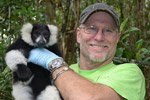
Have conservationists become too pessimistic for their own good—and the good of their cause? Tad Lo waterfalls in Laos. Photo by: Rhett A. Butler.
Here’s a challenge: take a conservationist out for a drink and ask them about their work. Nine times out of ten—or possibly more—you’ll walk away feeling frustrated, despondent, and utterly hopeless. You’ll hear about rainforests being chopped down for palm oil or chopsticks; or a just-discovered species that probably just went extinct; or a government that is worse than ambivalent: corrupt; or a shadowy corporation that’s doing some horrific thing to ecosystems and local people just to make greedy shareholders happy. If the talk goes broader—and more drinks are bought (you should probably pay: conservationists don’t make much)—you’ll probably hear about the globally rising temperatures and melting glaciers; how the oceans are practically empty and acidifying; how primary forests are mostly gone; how the human population just doesn’t stop growing; and how the bulk of the world’s species will likely be extinct in a couple hundred years anyway.
Yet, a few conservation scientists are not just trying to save species from extinction, but also working to save their field—their life’s work—from slipping into total despair. They argue that the increasingly-bleak tone from conservationists threatens to undercut recruiting future scientists and ignores the many positive stories that are happening on the ground. Worst of all, the constant pessimism may actually be causing the general public to tune out.
“Conservation biology has arguably become the most depressing of the sciences,” James K. Sheppard, a conservation scientist with the San Diego Zoo, told mongabay.com.
In 2010, Sheppard and his colleague, Ron Swaisgood, the General Scientific Director at Cocha Cashu Biological Station in Peru, wrote a paper in BioScience on how conservation science needs a little hope. The paper spurred a number of letters and, according to Sheppard, has proved to be his most popular article.
 Panda wearing a GPS collar. Panda populations have largely stabilized and may even be on the rise, according to expert Ron Swaisgood. Photo by China Academy of Sciences. |
“We can’t ignore the bad news; it is real and it would be a disservice to gloss that over,” Swaisgood said in an interview. “But, the human brain is wired to try harder only when there is reason to believe that those efforts will make a difference. Call it what you want, but the convenient label for this belief that one’s actions will make things better is ‘hope.'”
Swaisgood points to bleak messaging on climate change, which in the U.S., at least, may have played a significant role in delaying action and stirring denialism, according to a number of recent psychological studies.
“The Sword of Damocles over our head is not the image that is going to empower people to action. We need to engage people to join a movement that will make things better. Not better than they were, but better than they would be if we do nothing,” he said.
Conservation’s current gloom-and-doom view also threatens to squeeze out future conservationists who have more optimistic personalities, according to Sheppard.
“A pervasive culture of negativity in conservation will risk attracting only personalities that are overly pessimistic, instead of a healthy mix of hope and pragmatism,” Sheppard said. “These pessimistic types could drive the culture of conservation further towards despair, attracting even more pessimists to the field in a downward spiral of doom and gloom.”
Adding to this, Swaisgood said conservation professors need to think how such bleak messages are being viewed by young and impressionable students who want to make a difference in the world. Many of these students may choose other career paths if they are drowned by negativity in conservation.
“While we conservation biologists are reporting the rapid extinction rates of species, nuclear physicists are reporting the exciting discovery of new quantum particles,” the pair write in their 2010 paper. “While we try to raise the public profile of habitat destruction and warn of an Earth made depauperate by climate change, astronomers are uploading images of glorious vistas of pristine new worlds, beamed back from intrepid probes and space telescopes.”
It’s not that conservation science doesn’t have as many wonders, but that conservationists have largely used their media time to spell out disaster not share their discoveries and successes.

California condor with GPS tags. The last California condors were removed from the wild in the 1980s, today they have been reintroduced into the wild in California, Arizona, and Mexico. Without intensive conservation action the species would almost assuredly be extinct today. Photo by: James Sheppard/San Diego Zoo.
“Sharing our conservation success stories will provide proof of concept that positive actions can have positive outcomes; we must do better at sharing these stories, not just our darkest fears and most disappointing losses,” Swaisgood said. “Conservation scientists must lead this effort, not stand on the sidelines wagging their fingers dismissively at the naiveté of those that dare share a warm, fuzzy feel-good conservation success story.”
According to the scientists, there are many ways to bring hope back into the field without ignoring the massive challenges.
“This could include sessions and workshops at international conferences and symposia that describe conservation success stories. Journals could mandate that authors of scientific articles include a description of how their work will provide a more hopeful conservation outcome for their study species or habitat. Academic courses could imbue budding conservation biologists with a balanced view of conservation issues and encourage them to communicate a more hopeful message in media and public outreach,” Sheppard suggested.
Both Sheppard and Swaisgood have seen conservation succeed firsthand with California condors in Mexico and pandas in China, respectively.
“We don’t hear enough about critical habitats being successfully protected by new legislation or species being brought back from the brink by the heroic efforts of conservationists,” said Sheppard. “The result is that instead of inspiring hope and action we are promoting cynicism and apathy.”
Imagine taking that conservationist out for a drink again, but this time imagine hearing about how the white rhino went from a population of 50 to 20,000; imagine hearing about Brazil’s remarkable success in combating deforestation or how wolves are again howling across the U.S. and Europe; imagine hearing about the plummeting prices of wind and solar energy or how indigenous people are protecting their own forests; imagine learning about the ambitious Jaguar Corridor or the sudden explosion of Marine Protected Areas; imagine hearing about the dauntless conservation heroes who, day after day, year after year, fight to safeguard nature, and therefore ourselves. Or imagine just hearing about the wonder of spending a month in the cloud forests of the Andes, the awesomeness of scuba diving in a coral reef, or the beauty of an Atlas moth. With such stories in your head, it might be much easier than ever to hear about the environmental challenges facing humanity.
AN INTERVIEW WITH JAMES K. SHEPPARD AND RON SWAISGOOD

Over the long term the story of the white rhino is an incredible success. The species now numbers in the tens of thousands from a population of only around 50. However, that success is threatened today by a massive poaching crisis. Photo by: Rhett A. Butler.
Mongabay: What do you mean by a “culture of despair” in conservation?
James K. Sheppard: We have noticed a creeping despondency within the culture of conservation, which especially manifests conferences of conservation professionals and meetings of those of us who work at the frontline of species and habitat preservation and restoration. For example, after a recent international conference I joined a group of early-career conservation scientists and grad students for a drink in the hotel lobby. Everyone agreed that the standard of scientific research in the conference presentations was excellent. However, everyone also complained that the take-home message from most of the talks was very bleak. Conservation biology has arguably become the most depressing of the sciences!
My friends in other fields are reporting exciting new discoveries in biomedical research that can improve healthcare or they’re revealing astonishing images of the exotic worlds within our solar system, whereas we conservation scientists are describing the impending doom of this critically endangered animal or the inexorable devastation of that unique habitat.
Ron Swaisgood: Many of us in the conservation field feel beleaguered by bad news; we live it each day, not just in the news headlines but in the realities we face. We are dangerously close to adopting pessimism as our worldview. Like the office mates that complain constantly about the bad things the company administration does, we conservationists share a common water cooler moment that centers on how bad things are, how thoughtless is humankind, and how bleak the future appears. There is of course good reason for despair, but if we really feel this way, that it is hopeless, then we are only working for a paycheck. We need to re-engineer our worldview.
Mongabay: How might current messaging from conservationists actually make the situation worse?

James K. Sheppard. Photo courtesy of James K. Sheppard.
James K. Sheppard: A measure of despair is expected due to the trying nature of our work, which often pits small groups of dedicated, yet underfunded, conservationists against intractable forces of bureaucracy, greed, conflict, and ignorance. It’s part of the job description that we must grapple with on a daily basis. However, despair is also unfortunately being promulgated by the way that we deal with it—we have a tendency to over-report the negative aspects of conservation challenges while under-reporting the many positive successes. The conservation stories that get the most coverage are typically about poaching, coral bleaching or the extinction of an iconic animal etc. We don’t hear enough about critical habitats being successfully protected by new legislation or species being brought back from the brink by the heroic efforts of conservationists. The result is that instead of inspiring hope and action we are promoting cynicism and apathy.
Ron Swaisgood: We can’t ignore the bad news; it is real and it would be a disservice to gloss that over. But, the human brain is wired to try harder only when there is reason to believe that those efforts will make a difference. Call it what you want, but the convenient label for this belief that one’s actions will make things better is “hope.”
All too often, conservation appeals use fear to motivate the masses. This kind of negative messaging can be counterproductive, causing people to give up hope and cultivating a culture of despair. If all hope is lost, might as well party while you can. The good news is we are witnessing a sea change in how conservation organizations are crafting their messages for the public. More and more, you see them focusing on what can be done, with less attention to what we have already wrought. The Sword of Damocles over our head is not the image that is going to empower people to action. We need to engage people to join a movement that will make things better. Not better than they were, but better than they would be if we do nothing.
Mongabay: What can psychology tell conservationists about how to approach the media and the public?

A soy field meets the Amazon. Although many difficulties remain, Brazil has been hugely successful at reining in deforestation over the past decade. Photo by: Rhett A. Butler.
Ron Swaisgood: I am not a psychologist, but it is time we conservationists take some lessons from the growing body of empirical research that shows what motivates people to action. Conservation is inherently an action-based agenda, and our messages must motivate people to do more than write a check for their conservation NGO of choice. We cannot lie to the public, nor can we ignore the bad news; that would be disingenuous. But we can learn from the massive efforts to change behavior in the interest of public health and safety, for example.
To me, one of the most powerful examples of lessons learned from psychology comes from the massive, and largely failed effort to get the U.S. citizen to buy-in to the idea of climate change. No other issue has dominated conservation messaging more in our times, yet the belief that climate change is even real is eroding, and there is little political and public support to make tough decisions and sacrifices to reduce greenhouse gasses. Why have we failed so miserably to address this defining issue of our day? According to a prestigious think tank assembled by the American Psychological Association perhaps it is because of “Well-meaning attempts to create urgency about climate change by appealing to fear of disasters or health risks frequently lead to the exact opposite of the desired response: denial, paralysis, apathy, or actions that can create greater risks than the one being mitigated” (Swim J, Clayton S, Doherty T, Gifford R, Howard G, Reser J, Stern P, Weber E. 2010. Psychology and Global Climate Change: Addressing a Multi-faceted Phenomenon and Set of Challenges. American Psychological Association.)
Messages appealing to fears or “do this or else” approaches are far less likely to succeed than positive and empowering messages. Cultivating positive expectations that one’s actions will bring positive results (i.e., hope) is far more persuasive and successful at effecting change. Taking this lesson learned to conservation means we need to focus on what actions that can be taken that will bring about a brighter future, not how our failure to act will bring ruin. Sharing our conservation success stories will provide proof of concept that positive actions can have positive outcomes; we must do better at sharing these stories, not just our darkest fears and most disappointing losses. Conservation scientists must lead this effort, not stand on the sidelines wagging their fingers dismissively at the naiveté of those that dare share a warm, fuzzy feel-good conservation success story.
Mongabay: How do conservationists tell the truth about very real—and sometime depressing—issues, but also encourage action through hope?

Ron Swaisgood. Photo courtesy of Ron Swaisgood.
James K. Sheppard: We must never shy away from alerting the public to urgent conservation issues while biodiversity decline, species extinction, and habitat fragmentation continue to impact ecosystems, imperil livelihoods and degrade the function and beauty of our living planet. Indeed, it’s one of our core duties as conservation scientists to characterize the threats, sound the alarm, and rally efforts to effectively meet these challenges.
However, a steady stream of dire and depressing warnings will simply desensitize the public to the seriousness of the situation instead of galvanizing a helpful response. No wonder that recent public polls show that urgent environmental issues such as climate change are prioritized well below other concerns such as the national debt or immigration. We must do a better job of balancing the warnings with positive stories of how conservation efforts have successfully produced lasting benefits to endangered species and habitats and show that all of us can indeed make a real and meaningful difference.
Ron Swaisgood: It will be a delicate balancing act to share both the depressing realities and significant and real losses to nature while also sharing those stories of hope and success. It is extremely important to realize that the goal is not, nor should it be, to convince people that the environment is getting better, that Nature is okay, but rather it is to convince people that their actions can create a more positive outlook for nature than if they do not take action.
This more hopeful version of conservation has a sad undercurrent that acknowledges that there have been and will continue to be significant, often brutal, losses in the fight to conserve some remaining bits of our natural heritage.
Mongabay: How could pervading pessimism in conservation impact recruiting future conservationists, especially a diverse group?
 The Arabian oryx is the only species to date that has gone from Extinct in the Wild to Vulnerable on the IUCN Red List. Photo in the Public Domain. |
James K. Sheppard: If we draw a parallel with the natural world, we see that populations of animals with diverse personalities tend to have enhanced behavioral flexibility and survivability compared to more uniform groups. For example, a mixture of bold and shy individuals within a population may make the optimal response to a food resource opportunity (the bold animals) or a predator threat (the shy animals) more likely. This rule can be extrapolated to decision making in human groups. One of the defining attributes that contributed to the success of Franklin Roosevelt’s presidency was the unparalleled diversity of his carefully chosen cabinet. A personality tempered with a degree of pessimism might be able to navigate conservation realpolitik better than an unrealistic Pollyanna. However, a pervasive culture of negativity in conservation will risk attracting only personalities that are overly pessimistic, instead of a healthy mix of hope and pragmatism. These pessimistic types could drive the culture of conservation further towards despair, attracting even more pessimists to the field in a downward spiral of doom and gloom. Conservation needs a fortifying dose of hope and good news to attract a balance of personalities that can endure the slings and arrows of conservation challenges while developing and implementing effective conservation strategies.
Ron Swaisgood: I would ask that each person contemplating the impacts of conservation pessimism take a moment to put themselves in the shoes of a twenty-something year old college student selecting a career trajectory. Take a student who loves to work hard, be part of a cause bigger than herself, and (naively one may argue) wants nothing more than to help make the world a better place. She may see the cold, hard realities of a world in a bad situation, but desires nothing more than to make a difference. Now, place that person in a culture of despair, surrounded by professionals that constantly complain about how bad things are, and how nothing can be done aside from dramatic reduction in human population. The cognitive dissonance between her world view and the prevailing world view of this conservation community may place her at great risk of bailing, seeking out another avenue where her industry applied can make a difference—the fight against cancer perhaps or pet rescue for a humane society.
Now consider the conservation community she left behind, impoverished by her absence and many like her that might just believe in her cause enough to actually make a conservation success story of her own. Conservationists seem most adept at securing support from aging white atheists. Might a different approach bring in a more diverse group of supporters? Conservation success will require all types.
Mongabay: What is structured hope? How can this help conservationists change their perspective and their messaging?

Need a symbol of survival? The solenodon has survived the comet that destroyed the dinosaurs, the splitting-up of continents, the arrival of hungry humans, the clearing of forests, the invasion of alien species like rats and dogs, the landing of ruthless Europeans, and the rise of the modern world. Today two species survive, one in the Dominican Republic (and possibly Haiti) and the other in Cuba. Photo by: Jeremy Hance.
James K. Sheppard: There has recently been some promising discussion of the need for more hope in conservation within the scientific and general literature. However, we believe that in order for this conversation to engender real change away from pessimism we must develop and foster a paradigm shift towards structured hope. Becoming hopeful, like becoming happy, requires practice.
Structured hope refers to practices, rituals and tools that encourage us to develop and retain a more hopeful outlook on conservation while remaining pragmatic about conservation challenges. This could include sessions and workshops at international conferences and symposia that describe conservation success stories. Journals could mandate that authors of scientific articles include a description of how their work will provide a more hopeful conservation outcome for their study species or habitat. Academic courses could imbue budding conservation biologists with a balanced view of conservation issues and encourage them to communicate a more hopeful message in media and public outreach. Conservationists need to be regularly reminded to be hopeful.
Ron Swaisgood: Hope, like happiness, doesn’t always come easy. Research in the field of “positive psychology” indicates that people that actively cultivate rituals and habits that make them feel happy develop higher levels of happiness. In the idea of structured hope, we are proposing that to act more hopeful, we must become more hopeful, and to do that will require that we consciously strive to feel hopeful and to share experiences that bring about more positive outlooks on the future. We are proposing that conservation professionals (yes, even academics) institutionalize rituals that are an antidote to despair. The supposition is that it will require conscious effort until eventually the habit becomes second-nature.
Mongabay: How can spending more time in nature help both conservationists and the public at large?
Ron Swaisgood: Time in nature can be an antidote to pessimism because of the well-documented effects of nature on mental health. That effect should be especially pronounced in conservationists, who presumably came to this field out of a profound love for nature, and in almost all instance that love for nature stemmed from time spent in nature. Meaningful time in nature is a vanishing commodity, as society moves away from nature in the Information Age or the Video Age. Or, in the case of conservationists, perhaps the Paperwork Age (digital or on dead processed trees).
Time in nature can have powerful restorative results, and is well known for its ability to lift spirits. The public at large can benefit from better physical and mental health, conservation can benefit from recruitment of more people to their cause, and professional conservations can remember why they got involved in the movement in the first place, providing powerful motivation to keep up the effort, and, perhaps, cultivating a bit more hope themselves.
More on this topic can be found in these blogs:
- Swaisgood 2013. Conservation exhaustion and the children and nature movement.Children and Nature Network.
- Swaisgood, RR. 2010. From the neighborhood creek to the Institute for Conservation Research: transformational experiences in nature. San Diego Zoo’s Conservation Blog.
- Swaisgood, RR. 2010. The gift of nature, shared: how we launched our family nature club. Children and Nature Network.
Mongabay: Let’s end this on a happy note. Where do you see hope in conservation today?

Thanks to conservationists, the California condor is taking to the skies again. Photo by: James K. Sheppard/San Diego Zoo.
James K. Sheppard: The really heartening thing about hope in conservation today is that it’s actually all around us—you often just have to dig a little to find it. For example, San Diego Zoo Global where we work has many local, national and international conservation success stories to be proud of and these provide much-needed examples of how committed groups of scientists, veterinarians, management agencies, private sector interests and the concerned public can come together and coordinate amazingly effective conservation programs.
Just a few years ago the skies of Mexico were deprived of California condors. Now, with the help of our Mexican colleagues, there are more than 30 of these magnificent birds soaring over Northern Baja including the first chicks successfully produced in wild since the species was extirpated in the 1940s. The hope is out there, we just need to do a much better job of spreading it.
Ron Swaisgood: The frontline conservationists are winning battles with hope everyday. Sometimes they have to remind themselves of this fact, but they are in fact making headway on many of today’s important conservation issues. The science of conservation has matured and blossomed and we have a vast storehouse of knowledge to guide conservation action. Without doubt, many challenges lie ahead but real hope lies in the actions of the tireless stewards of nature.
Personally, I take great hope in the changed circumstances of the giant panda, a species I have worked with for 19 years. When I started work with this iconic species, the outlook was bleak, hence the title of George Schaller’s seminal work, “The Last Panda.” Over the years progress has been remarkably steady, despite setbacks and worrisome developments. Great hope can be found in the will of the Chinese government, which has set aside more than 60 protected areas for pandas (and their co-occupants), banned logging, and instigated a massive reforestation program. Forest cover is actually increasing in China. Alongside these efforts, scientists have worked to gain a deeper understanding of pandas’ ecological requirements, improved conservation management strategies, and turned around the struggling conservation breeding program, once notorious for its failures. As a result the wild population is stabilizing and may be increasing. I feel privileged to have been a part of these efforts, and it brings me hope on a personal level.
Citations:
- Swaisgood, Ronald R., and James K. Sheppard. “The culture of conservation biologists: Show me the hope!.” BioScience 60, no. 8 (2010): 626-630.
Related articles
What’s an environmental journalist to do with so much good news?

(06/12/2014) As an environmental journalist covering stories from the great Arctic ice melt to the rhino poaching crisis in Africa, you’ll forgive me if sometimes in the morning—before I turn my computer on—I have a sudden desire to spend a few extra minutes in bed or have a leisurely breakfast with my daughter or just sit in the back yard with a cup of tea and a good book.

(08/12/2014) Shark fin demand has dropped precipitously in China in just a few years, according to a new report by WildAid. Shark fin traders in Guangzhou—the current informal capital of the shark fin trade—say their sales have fallen by 82 percent in just two years, according to WildAid.
Cargill to cut off suppliers who don’t provide deforestation-free palm oil

(07/30/2014) Agricultural giant Cargill, America’s largest palm oil importer, will no longer buy palm oil from sources associated with deforestation, conversion of peatlands, and social conflict. The policy follows similar commitments made by other major palm oil buyers, including Unilever and Nestle, and comes after years of campaigning led by the Rainforest Action Network.
Next big idea in forest conservation: Reconnecting faith and forests

(07/24/2014) ‘In Africa, you can come across Kaya forests of coastal Kenya, customary forests in Uganda, sacred forest groves in Benin, dragon forests in The Gambia or church forests in Ethiopia…You can also come across similar forest patches in South and Southeast Asia including numerous sacred groves in India well-known for their role in conservation of biological diversity,’ Dr. Shonil Bhagwat told mongabay.com.
Targeted enforcement saved a Massachusetts-worth of Amazon rainforest in 3 years
(07/24/2014) Targeted law enforcement efforts via Brazil’s green municipalities programs were responsible for reducing deforestation by 10,653 square kilometers — an area the size of Massachusetts — between 2009 and 2011, argues a paper published in the journal Land Use Policy.
Brazil could meet all its food demand by 2040 without cutting down another tree

(07/24/2014) Better utilization of its vast areas of pasturelands could enable Brazil to dramatically boost agricultural production without the need to clear another hectare of Amazon rainforest, cerrado, or Atlantic forest, argues a new study published in the journal Global Environmental Change.
Lush Cosmetics launches bid to protect pangolins
(07/24/2014) Lush Cosmetics has agreed to support an effort to battle trafficking of the Sunda pangolin.
Rare bird paradise protected in war-torn Colombian mountain range (photos)

(07/22/2014) A coalition of conservation groups have established a new protected area in one of Latin America’s most neglected ecosystems: the Colombian-side of the Serranía de Perijá mountain range. Following decades of bloody conflict and rampant deforestation, experts say only five percent of rainforest is left on the Colombian side of this embattled mountain range.
Coastal wildlife paradise declared biosphere reserve in Argentina (PHOTOS)

(07/15/2014) Conservationists are celebrating the announcement that UNESCO has dubbed Argentina’s Península Valdés a biosphere reserve under the Man and Biosphere Program (MBA). A hatchet-shaped peninsula that juts out into the Southern Atlantic Ocean, the world’s newest biosphere reserve is home to a hugely-diverse collection of both terrestrial and marine wildlife.
Next big idea in forest conservation? Rewards for reforestation

(07/10/2014) Susie McGuire and Dr. Edward Louis Jr. are the powerhouse team behind the Madagascar Biodiversity Partnership (MBP), an NGO that involves local residents—both human and primate—in reforestation efforts in Madagascar. A conservation geneticist and veterinarian by training, Ed Louis has discovered 21 lemur species and successfully reintroduced two species of locally extinct lemurs back into the wild.
Stuff of fairy tales: stepping into Europe’s last old-growth forest

(07/09/2014) There is almost nothing left of Europe’s famed forests, those that provided for human communities for millennia and gave life to the world’s most famous fairytales. But straddling the border between Poland and Belarus, the Bialowieza Forest is Europe’s last lowland old-growth forest, parts of which have never been cut by man.
On babies and motherhood: how giant armadillos are surprising scientists (photos)
.150.jpg)
(07/01/2014) Until ten years ago scientist’s knowledge of the reproductive habits of the giant armadillo— the world’s biggest— were basically regulated to speculation. But a long-term research project in the Brazilian Pantanal is changing that: last year researchers announced the first ever photos of a baby giant armadillo and have since recorded a second birth from another female.













